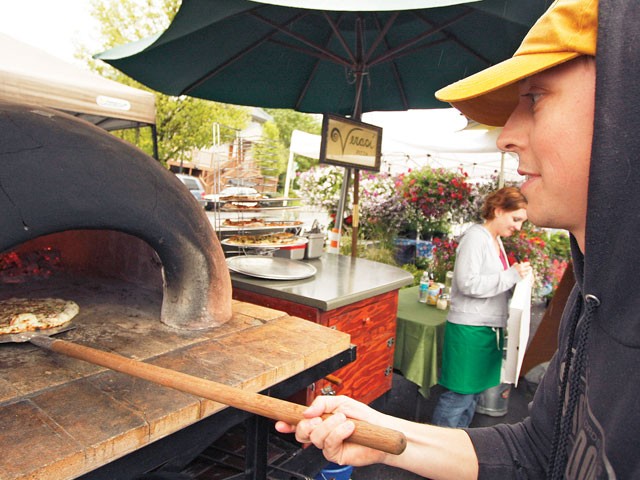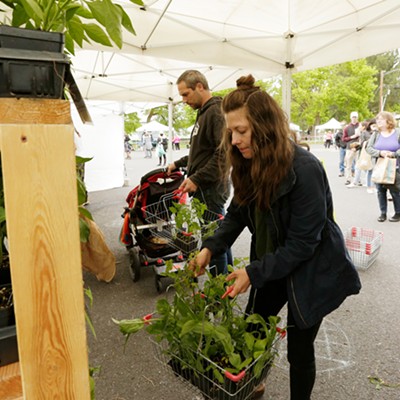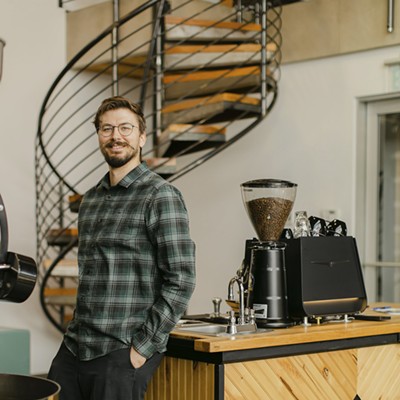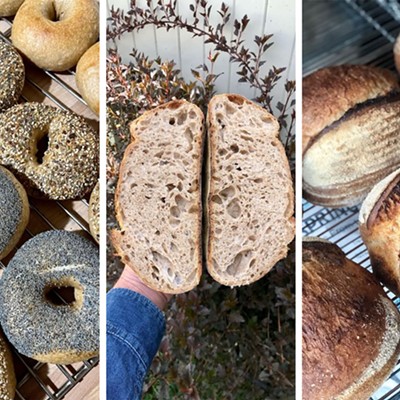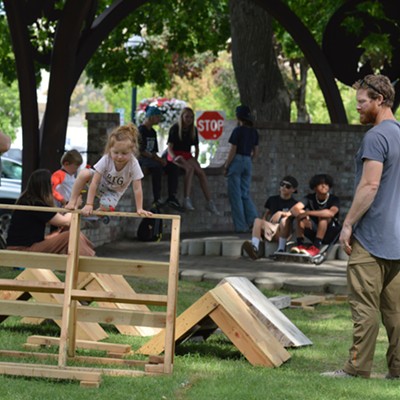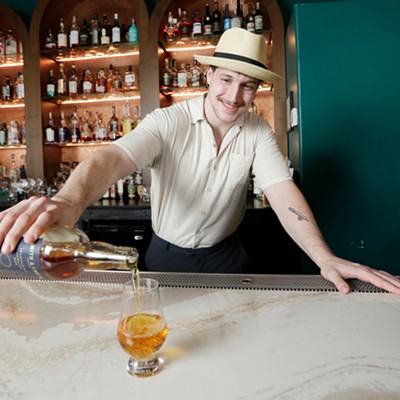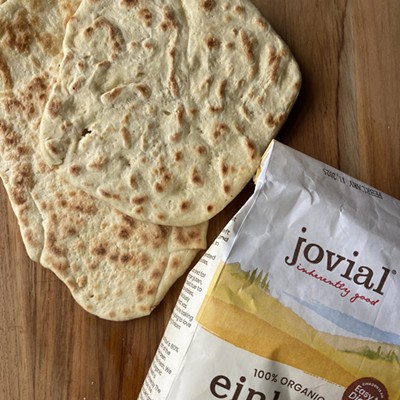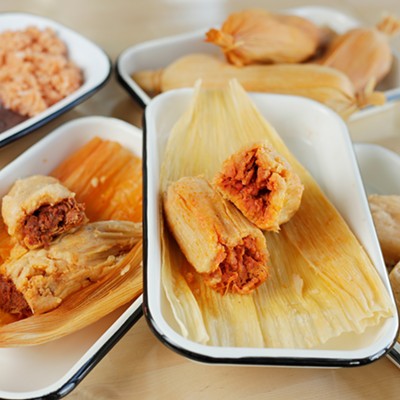The crust begins to rise almost immediately. After 25, maybe 30 seconds, it starts to bubble. Tiny little bubbles all along the edges. Some bigger ones, too, the dough inflating like a balloon. Rolled pie-thin initially, the crust takes on a topography like undulating hills. The cheese, a grated heap — sometimes topped with additional feta or ricotta or discs of fresh mozzarella for good measure — melts nearly flat, exposing toppings like fossils in an eroded flood plain.
As this is happening, Seth Carey is working his pizza peel around the edges until it slides freely on the brick. Soon the cheese begins to boil. In less than a minute, the crust has risen and stiffened, but, oddly, hasn’t really begun to brown. Carey, with a flick of his peel, spins the pizza half a turn and the end state is revealed.
While the heat radiating from the brick has been vaporizing the moisture in the crust, creating a spongy loft; and the air off the fire, pulled by convection over the face of the pizza and out the mouth of the oven, has been flash-cooking the toppings; the direct heat from the apple wood coals — all 800 to 1,000 degrees of it — has been broiling brown the cheese, forming a crisp layer over the crust and lightly charring the points closest to the coals.
Carey leaves the pizza in the oven for another 40 seconds or so, then pulls it out — both sides evenly browned, the cheese still bubbling in spots like molten, off-white lava.
If the pizza is “for the box” — meaning bought whole, Carey cuts it into eight slices. If it’s for the rack — to be bought by the slice — he cuts it in quarters. Either way, if it’s later than, say, 10:30 in the morning, the pizza will be gone nearly as quickly as it cooked.
It’s 6 am on a Saturday, three hours before the Liberty Lake Farmers market opens, and Seth Carey is bouncing around the open-concept living/dining room of his East Eighth Avenue home, checking items off a sheet of paper. When he started Veraci in Spokane last summer, Carey used to keep this list in his head, but the cost of missing something was too high.“You forget, like, dough bins, and you’re screwed,” he says, patting the dough, which sits in a 20-quart tub, slowly unfurling itself.
Out back, behind Carey’s Dodge Ram, is a flatbed trailer tricked out with cabinetry made of nautical plywood and a wood-fire pizza oven of brick and refractory ceramic clay. Carey built it by hand, taking the design from Marshall Jett and Erin Byrd, the creators of Veraci in Seattle. Carey worked for the Byrds before moving here and building his own pizza oven last May. While the oven took months to cure, giving Carey a late start on the market season, he’s still happy with the response that it has received.
Map the Region's Food Carts
Veraci Pizza never stays in one place long. Seth Carey publishes his itinerary, though, so you can find him easily. Look for him at the Coeur d'Alene Farmers Market on Wednesdays from 4-7 pm, at South Perry on Thursdays from 3-7 pm and at the Liberty Lake Farmers Market on Saturdays from 9 am-1 pm. (View this map in a larger format.)
Having literally built the stove from the trailer bed up and doing the same weekly with the dough and toppings (it takes more than 30 hours of prep for 11 total hours at area farmers markets) Carey has an intimate relationship with everything Veraci.
When Peter Froese — the guy who helps with this early-morning ritual, despite clearly not being a morning person — arrives a little before 6 am, Carey is waiting with coffee. Carey treats the dough like a favored child. Froese is groggy this morning and — because of the atmospheric conditions — so is the dough. “It’s waking up too,” Carey says, patting the tub again.
Carey, in contrast, is clearly a morning person. Their first year, “He’d get up at like 3 am,” Froese says. “I’d get here at 6 and he’d be like vooooooo!” Two days earlier, at the South Perry Farmers Market, it had rained buckets. They still made out all right, but the conditions were horrible. It’s a fact of life Carey seems to relish: “It’s, like, through sleet or snow or rain … totally makes us that much more hardcore.” Today the forecast looks sunny.
When Carey puts his truck into gear and heads off to market, the dough rides shotgun. Froese drives separately.
The wood Carey uses is mostly apple wood, taken from area orchards. The smell of the fire it produces is earthy and sweet. In Froese’s mind, “the smell is connected with groggy mornings.” And probably with getting body hair singed off. Even early in the firebuilding process, the heat convecting out the mouth of the fire is roaring hot. Froese had recently cut the back of his hair into a buzz, because an errant lick of heat had almost burned the front of his hair.It takes an hour and a half to get the fire up to temperature, so Veraci sets up before almost any of the other vendors. Once the crowds show up, the process of pizza-making turns into a kind of sideshow attraction. Kids gawk.
Self-proclaimed grillmasters and weekend warriors talk specs (they ask, but Carey doesn’t give them out). By 9 am, a steady stream of people are walking up — pointing, gawking and occasionally buying. “I love the anticipation it builds,” Carey says, of watching a pizza cook. It’s a feeling aided by the farmers market itself. People come here with the intent to take home fresh ingredients and cook their own food. Veraci’s oven is like a master class demonstration.
Carey would like the spectacle to develop even more, but he’s hamstrung, to a degree, by local laws.
The Veraci Pizza carts in Seattle take produce from whatever market they’re at to create their pizzas, and they make the dough on-site, offering a glimpse of the entire pizza-making process. The Spokane Health District won’t let Carey do any of that. “They say it’s just too much preparation onsite.” Though the codes for both Spokane and King counties are drawn from the same state code, application seems to vary.
Carey thinks it’s a shame on multiple fronts, both inhibiting the freshness of the pizza and dulling the spectacle of watching a pizza arise not just from dough and cheese and toppings, but from flour and water and yeast and whole vegetables.
Still, people at Liberty Lake appreciated the show.
As the day wore on, more and more of the gawkers walked away with slices ($4-$4.50) and whole pies ($16-18). Carey says he needs to sell 20 pizzas a market to cover costs. That Saturday he sold 65, which builds the kind of profits he needs for his ultimate plan. Carey wants soon to have made enough money off the wagon to open his own sit-down Veraci restaurant. It certainly worked in Seattle. Within four years, the original fleet of traveling pizza ovens bore a fixed-location pizzeria in Ballard.
The quality of each pizza that comes out of the oven is incredibly high; when Spokane gets its own sit-down Veraci, the pizza establishment here will tremble.
Until then, you’ll find Carey and his crew in the spring and early summer, at one of three markets, “come sleet or snow or rain,” or whatever else. Which, really, makes them so much more hardcore.

